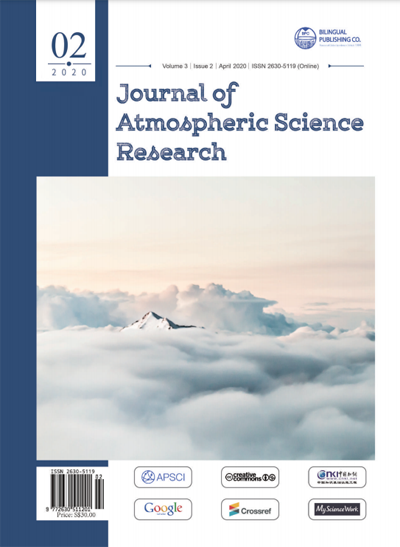-
861
-
411
-
362
-
359
-
350
Characterization of PM2.5 Mass Concentration in the Onshore of Sanya, China
DOI:
https://doi.org/10.30564/jasr.v3i2.2134Abstract
Numbers of real-time data (E-BAM) of PM2.5 were collected in the period from Jan 8th 2012 to Jan 1st 2013 at the laboratory of Tropical Ocean University (Sanya, China). The average mass concentration was 19.7 μg/m³. The highest 40.5 μg/m³ in October compared to the lowest 14.1 μg/m³ in July. From a seasonal perspective, the average PM2.5 mass concentration in fall and winter are relatively higher than that in both spring and summer. On the basis of satellite map of fire points and backward trajectories of the air masses, we primarily deduced that the PM2.5 in Sanya may be caused by the biomass burning and industrial pollutants from the area of Pearl River Delta of China and the Indo-China peninsula (e.g. Vietnam, Laos).
Keywords:
Sanya; PM2.5; Carbonaceous aerosol; Biomass burningReferences
[1] Cao, J.J., Zhu, C.S., Tie, X.X., Geng, F.H., Xu, H.M., Ho, S.S.H., Wang, G.H., Han, Y.M. and Ho, K.F. (2013), Characteristics and sources of carbonaceous aerosols from Shanghai, China, Atmospheric Chemistry and Physics, 13(2), pp.803-817.
[2] Chang, T.J., Kao, H.M., Wu, Y.T. and Huang, W.H. (2009), Transport mechanisms of coarse, fine, and very fine particulate matter in urban street canopies with different building layouts, Journal of the Air & Waste Management Association, 59(2), pp.196-206.
[3] Hua, Y., Wang, S., Wang, J., Jiang, J., Zhang, T., Song, Y., Kang, L., Zhou, W., Cai, R., Wu, D. and Fan, S. (2016), Investigating the impact of regional transport on PM2.5 formation using vertical observation during APEC 2014 Summit in Beijing. Atmospheric Chemistry & Physics, 16(24).
[4] Huang, R.J., Zhang, Y., Bozzetti, C., Ho, K.F., Cao, J.J., Han, Y., Daellenbach, K.R., Slowik, J.G., Platt, S.M., Canonaco, F. and Zotter, P. (2014), High secondary aerosol contribution to particulate pollution during haze events in China, Nature, 514(7521), p.218.
[5] Li, C., Fu, J., Sheng, G., Bi, X., Hao, Y., Wang, X. and Mai, B.(2005), Vertical distribution of PAHs in the indoor and outdoor PM2.5 in Guangzhou, China, Building and Environment, 40(3), pp.329-341.
[6] Qin, X., Yan, H., Zhan, Z. and Li, Z. (2014), Characterizing vegetative biomass burning in China using MODIS data, International journal of wildland fire, 23(1), pp.69-77.
[7] Reddy, M.S. and Venkataraman, C. (2002), Inventory of aerosol and sulphur dioxide emissions from India. Part II—biomass combustion, Atmospheric Environment, 36(4), pp.699-712.
[8] Shen, Z., Cao, J., Zhang, L., Zhang, Q., Huang, R.J., Liu, S., Zhao, Z., Zhu, C., Lei, Y., Xu, H. and Zheng, C.,(2016), Retrieving historical ambient PM2.5 concentrations using existing visibility measurements in Xi'an, Northwest China, Atmospheric Environment, 126, pp.15-20.
[9] Sun, Y., Song, T., Tang, G. and Wang, Y. (2013), The vertical distribution of PM2.5 and boundary-layer structure during summer haze in Beijing, Atmospheric Environment, 74, pp.413-421.
[10] Tian, Y.Z., Wang, J., Peng, X., Shi, G.L. and Feng, Y.C.(2014), Estimation of the direct and indirect impacts of fireworks on the physicochemical characteristics of atmospheric PM10 and PM2.5, Atmospheric Chemistry and Physics, 14(18), pp.9469-9479.
[11] Wang, J., Ho, S.S.H., Cao, J., Huang, R., Zhou, J., Zhao, Y., Xu, H., Liu, S., Wang, G., Shen, Z. and Han, Y. (2015), Characteristics and major sources of carbonaceous aerosols in PM2. 5 from Sanya, China, Science of the Total Environment, 530, pp.110-119.
[12] World Health Organization, (2006), WHO Air quality guidelines for particulate matter, ozone, nitrogen dioxide and sulfur dioxide-Global update 2005-Summary of risk assessment, 2006, Geneva: WHO.
[13] Wu, Y., Liu, J., Zhai, J., Cong, L., Wang, Y., Ma, W., Zhang, Z. and Li, C. (2018), Comparison of dry and wet deposition of particulate matter in near-surface waters during summer, PloS one, 13(6), p.e0199241.
[14] Yang, Y., Liu, X., Qu, Y., An, J., Jiang, R., Zhang, Y., Sun, Y., Wu, Z., Zhang, F., Xu, W. and Ma, Q. (2015), Characteristics and Formation Mechanism of Continuous Hazes in China: A Case Study in Autumn of 2014 in the North China Plain, Atmospheric Chemistry & Physics, 15, pp.8165-8178.
[15] Zhang, G., Li, J., Li, X.D., Xu, Y., Guo, L.L., Tang, J.H., Lee, C.S., Liu, X. and Chen, Y.J. (2010), Impact of anthropogenic emissions and open biomass burning on regional carbonaceous aerosols in South China, Environmental pollution, 158(11), pp.3392-3400.




 Ping Wang
Ping Wang





